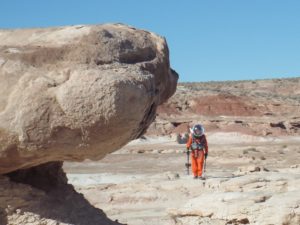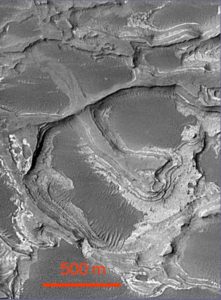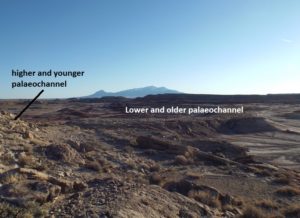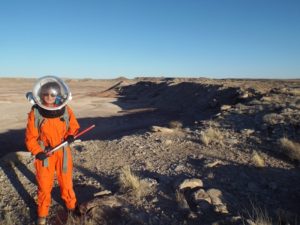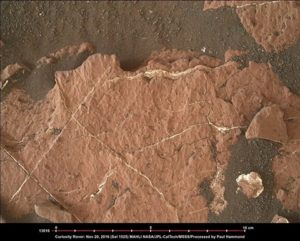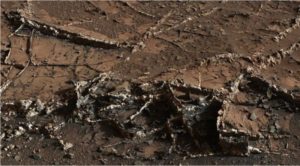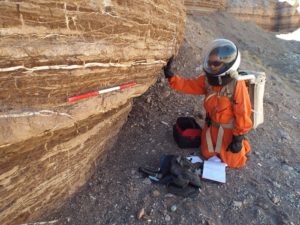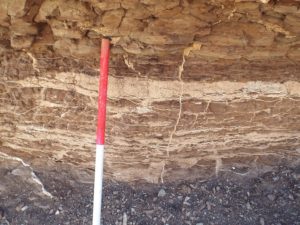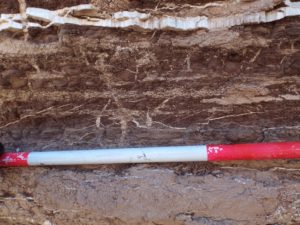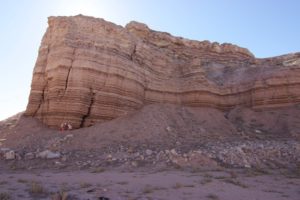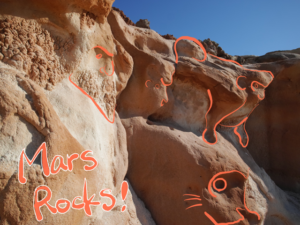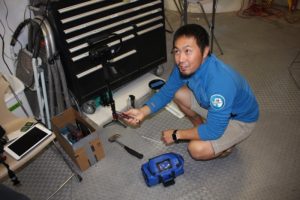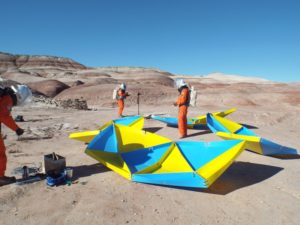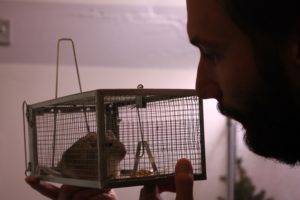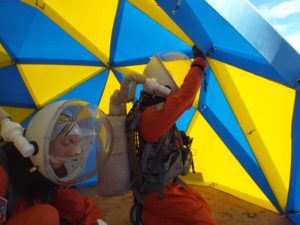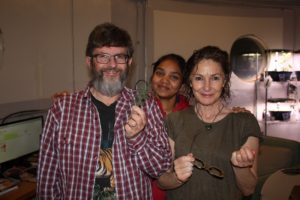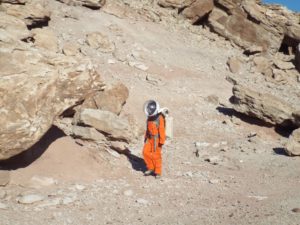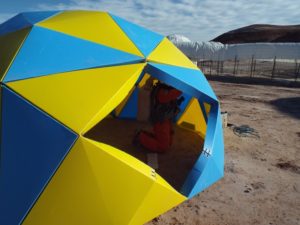
Archive: 26 Nov 2016
EVA Narrative – November 26th
EVA NARRATIVE 25/11/16
Jon Clarke
The new Polaris Ranger electric rover, a useful addition to the MDRS inventory
Yesterday Annalea and I took the new electric rover (a Polaris Ranger two seat 4WD vehicle) on its first EVA. We headed north along Cow Dung Road and stopped and two localities. While more limited in range than the petrol-powered quad bikes, its range is more than adequate for working at MDRS. We found it a superb vehicle for our purposes, capable, easy to drive, comfortable, with good load carrying capacity, and safe. It is preferable in many ways to the quad bikes and a much better Mars analogue. Astronauts on Mars will almost certainly use small unpressurised vehicles for working at short distances from the station. Two-person EVA teams can use two such vehicles to provide mutual support on sorties of up to half a day’s drive from the station, which might be as far as 50 km. Such vehicle could be fitted with a range of basic earth moving tools such as tip trays, buckets, and blades, much as the terrestrial counterparts can.
Exhumed and inverted crossing palaeochannels in Eberswalde Crater, Mars (NASA/MSSS)
Our other objective was to look determine the relationships between crossing exhumed palaeochannels. These have been observed on Mars, most famously at the delta in Eberswalde crater. They are significant because they show that there are different generations of palaeochannels present, those higher in the landscape are higher in the stratigraphy and thus younger than those lower down, even though they were deposited as part of the same overall depositional system.
Crossing exhumed and inverted Jurassic palaeochannels near MDRS. “A” and arrow shows the position and viewpoint of Figure 3. Google Earth image.
Crossing channels are also found at several locations at MDRS. While they can be mapped on Google Earth, teir flow direct needs to be confirmed on the ground. Their relative timing is also not always obvious in Google Earth, so this too has to be checked on the ground by determining which is higher and which is lower. On this EVA we checked two such locations north of the station. We parked the rover on the edge of the read and walked to them, a round trip of about 3 km. We were able to determine palaeocurrent directions and timing relationships between all palaeochannels visited. For example Figure 4 shows one palaeochannel as clearly higher in the landscape and thus younger than the lower.
View south from position “A” in Figure 3. Photograph taken from higher and thus younger palaeochannel than the lower one
For me this was one of the most rewarding EVAs of the expedition to date. Not only was there useful science achieved, but we successfully tested a new and useful piece of equipment. Looking forward to collecting the final details on the palaeochannels and further driving in the electric rover.
Sol Summary – November 26th
Sol Summary Report (SSR):
Sol# 64
Person filling out report: Annalea Beattie
Summary Title: Dome Day EVA.
Mission Status: on track
Sol Activity Summary:
The mornings are cold now and there is ice outside in any puddles left over from the rain. We began our day with plant care and at the briefing after breakfast we scoped out what’s needed for today. There was one EVA today – finishing the assembly of Yusuke’s dome project outside (as well as moving the water tank and taking out rubbish). The Dome briefing was in the morning and in the afternoon the dome was built near the tunnel. This was physical and difficult for those in the spacesuits – Jon, Anastasiya, Yususke and Claude-Michel. They all worked hard and are now all very tired. Anu read and wrote. Alex worked on his SuiTT interface all day, (tomorrow is another day for the interface), space.com for me all day and I re-interviewed Claude-Michel. This week I’m writing about his time here as Crew Engineer, smartpots, and habitability. HSO reports today on our health and wellbeing. We miss Jerry who was caught in a rat trap a couple of days ago and taken down to the dry creek bed where he was released. We hope he finds his parents. Something has changed now he has gone.
Reports Submitted to CapCom:
- Sol Summary- Annalea
- Post- Anu
- EVA report -Jon
- Mars Rocks 2- Yusuke
- Pictures -Anastasiya
- Photo of the Day – yes
MDRS lessons:
Anastasiya learnt fine motor skills in her spacesuit gloves, assembling Yusuke’s dome.
Plans for tomorrow: Day off.
Crew Physical Status: Very well.
Weather: Chilly.
Anomalies: There is an odd smell near Yusuke’s room.
It’s actually under the stairs we think.
We can’t find where it is, maybe it’s the pine tree or the borage or bell peppers.
Science Post – November 26th
Gypsum Astrobiology
By Crew Biologist Anushree Srivastava
On Earth, gypsum (CaSO4.2H2O) is deposited via evaporation of calcium and sulphate rich water. Gypsum is fragile, mostly translucent and occurs as thick, sedimentary evaporite beds. It is fairly common mineral on Earth and can be found around the salt lakes, hot springs, and veins of sulphate solution. Since it is relatively easily dissolved in the water gypsum is rarely found at the surface except in deserts. In hydrothermal systems, gypsum can be formed when anhydrite (CaSO4) is exposed to the near-surface groundwater. Buick & Dunlop in 1990 recorded ancient evaporitic environment of gypsum as old as Archaean (3.5 billion years old).
Several robotic missions to Mars, such as Omega instrument of ESA’s Mars Express Orbiter detected gypsum deposits on various locations on Mars in 2005 and then in 2013 Curiosity rover discovered the veins of gypsum in the fractured bedrocks in Gale crater, the location known as Yellowknife Bay. These occurrences of gypsum sediments in the crater is suggestive of the presence of the ancient lake in that location when Mars was warmer and wetter, which evaporated and the salty water precipitated in the form of gypsum.
Figure 1 a,b: Gypsum on Mars
Gypsum on Earth has been identified as home to endolithic communities in multiple extreme environments, it is therefore of great astrobiological interest. Culka and coworkers (2014) detected the carotenoid pigments from halophilic endolithic communities within stratified gypsum crusts using a miniaturized Raman spectrometer. Studies suggest that terrestrial halite/gypsum encrustations in the tidal regions are habitats of ‘endoevaporitic communities’ and these evaporitic environments were habitable even in the Archaean eon. Moreover, the Atacama Desert in Chile is the ideal Martian analogue as it is a hyperarid environment and the surface is hostile for any life to be able to survive. However, gypsum crystals in halite crusts host photosynthetic microbial life which might got encapsulated in the evaporite when this region desiccated in the ancient past. Therefore, for these reasons, gypsum is considered to be a potential target in the search for biosignatures in similar Martian evaporite deposits.
Gypsum deposits in the Utah Desert belong to the Jurassic and Cretaceous sediments that date back 200-100 million years old. As part of Mars 160 science goals, we intend to study these ancient gypsum sediments from astrobiological perspectives for the very first time here at Mars Desert Research Station. We intend to detect any signature of halophilic life inside the ancient gypsum which would be indicative of prolonged survival potential of these microbes. We have collected gypsum samples from Summerville Formation of Jurassic age. Summerville Formation is characterized by the alternating red-brown colour rippled sandstone and shale with mud cracks and white gypsum; to my amazement, white and pattern like coconut! In 1991, Caputo and Pryor described the Summerville deposition as deposited under “mud rich, restricted, evaporative, hypersaline conditions”. This formation is noted to be a tidal deposit of the Jurassic Epicontinental Sea. Thus, considering the antiquity of these deposits, our work on gypsum astrobiology will be significant to test if any trace of dormant or extinct life encased inside the fluid-inclusions of these crystals.
Figure 2 a, b, c, d: Gypsum veins of Summerville Formation.
Further Reading:
Allwood AC, Burch IW, Rouchy JM, Coleman M (2013) Morphological Biosignatures in Gypsum: Diverse Formation Processes of Messinian (∼6.0 Ma) Gypsum Stromatolites. Astrobiology. 9: 870-886.
Buick R, Dunlop J.S.R 1990 Evaporitic sediments of early Archean age from the Warrawoona Group, North-Pole, Western Australia. Sedimentology. 37: 247–277
Culka A, Osterrothová K, Hutchinson I, Ingley R, McHugh M, Oren A, Edwards HG, Jehlička J (2014) Detection of pigments of halophilic endoliths from gypsum: Raman portable instrument and European Space Agency’s prototype analysis. Philos Trans A Math Phys Eng Sci. Dec 13: 372



